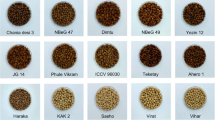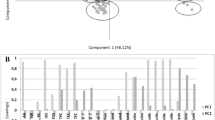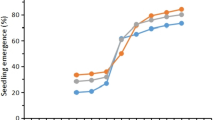Abstract
Three different varieties of kabuli-type chickpeas were cultivated in three different cultivation areas and for two years. An evaluation was carried out to see the effect of year, of variety and cultivation area on the nutritional value of chickpeas i.e. the proximate composition, the sugars (starch, non-starch polysaccharides, rafinose series oligosaccharides and sucrose) and tannins and phytic acid contents. The cultivation area, the cultivation year and the plant variety, as well as their interactions significantly affect the composition and the sugars contents in chickpea. High proportion of the total variation for all studied parameters explained by the main effects of variety indicates a significant heritability for them. Cultivation area was found to have a significant effect on starch contents, RSO, tannins and phytic acid. Year was found to affect fat contents, NSP and sucrose contents. Rainfall is the climate characteristic that may be responsible for these year-dependent differences.
Similar content being viewed by others
Explore related subjects
Discover the latest articles, news and stories from top researchers in related subjects.Avoid common mistakes on your manuscript.
Introduction
Chickpeas (Cicer arientinum) are considered to be important legume species traditionally cultivated in Greece and in the Mediterranean area. The contents of antinutrients and the proximate composition of chickpeas have been studied in various studies, while there has been extended literature on the effects of post-harvest handling and processes on the nutritional quality and antinutrients of chickpeas [1–8]. There has also been some sporadic correlation of the proximate composition and nutritional quality with the biotype or cultivar [1, 9] of chickpeas. A study also exists on the effects of location and variety on the morphological characteristics and cooking quality of chickpeas [10].
However, no systematic studies exist on the combined influence of cultivation area, cultivation year and variety on the proximate composition and antinutrients contents of chickpeas. Thus, the aim of this study was to evaluate how these factors and their interaction influence the nutritional value of chickpeas and specifically the proximate composition and antinutrient contents.
Material and methods
All the studied legumes were cultivated in the fields of Fodder Crops and Pasture Institute and were low-tannin experimental varieties. A 3×3×2 factorial experiment was conducted: three varieties of chickpeas were studied, each one of them was cultivated in small experimental plantations in three cultivation areas, and for two subsequent cultivation years, 2003 and 2004. The exact growing locations were: Palamas (39°27′43″N, 22°04′22″E), Fytorio (39°45′15″N, 22°51′40″E) and FCPI (39°45′15″N, 22°51′45″E), and the total field sizes were 15, 43 and 53 ha respectively. Allotments dimensions were 2 m×10 m. Each plot consisted of seven rows 25 cm apart from each other, while the distance between the plots was 75 cm. Chickpeas varieties were cultivated without any specific experimental design (simple arrangement of the plots) and sowing was made in different positions of the field for the two years to avoid soil exhaustion.
The soil characteristics in each cultivation area and the varieties characteristics are presented in Tables 1 and 2 respectively. The meteorological data for the 2 years in the studied areas are presented in Table 3.
Harvesting took place in June for all cases, when all seeds were dry. The whole harvests were mechanically homogenized (ball milling) and all analyses took place in triplicate in the produced meals. Protein, fat, moisture and ash contents were analyzed according to the AOAC [11]. Total starch determination took place enzymatically using Megazyme Total Starch Assay kit (AA/AMG) (Megazyme International, Ireland) [12]. A slight modification of the Dimethylsulphoxide methodology was followed, with a 15-min incubation in boiling water bath and continuous stirring.
The Raffinose Series Oligosaccharides (RSO) consisting of raffinose, stachyose and verbascose, as well as the sucrose and d-glucose contents were determined enzymatically (Megazyme Raffinose/d-Glucose Assay Kit, Megazyme International, Ireland) [13]. Total non-starch polysaccharides (NSP) were determined spectrophotometrically based on the method of Englyst et al. [14]. Total NSP content was calculated by using the standard curve derived from a standard sugar solution (7.612 g/l arabinose, 6 g/l glucose, and 3.878 g/l galacturonic acid) modified from the initial sugar solution proposed by the authors. The modified standard solution was based on the actual sugar proportions found in chickpea [15].
Total tannins were extracted by the method of Budini et al. [16]. Their contents were determined by a photometric method. [17]. Phytic acid determination took place in defatted material by a slight modification of the AOAC [11] anion-exchange methodology. Specifically, heating of the extract following the ion exchange was conducted in heat-mantles instead of the proposed Kjehldahl, in order to achieve gradual and uniform heating and to avoid loss of sample due to fluxing.
The statistic analysis was made by SPSS 10.0 computer software. Comparison of proximate composition and antinutrients of different groups was made by two-way analysis of variance (ANOVA) with variety and cultivation area considered as the independent factors. The t-test was used to compare means for the 2-year groups. Tukey-HSD test, with confident levels 95% was used for comparison of the means. The different parameters were correlated with each other by Pearson two-tailed significance correlation.
Results and discussion
Protein, fat moisture and ash contents of the studied chickpeas are presented in Table 4. In general, the proximate compositions of the present study confirm the values found in the literature, where protein ranged from 16.6 [18] to 25.9% [19], and fat from 3.0–4.6% [1].
Starch contents (Table 5), negligible glucose contents and NSP levels are similar to those reported in the literature [15, 19–21]. RSO levels were found lower than those in various chickpea types that exceeded 6% [19], and 7.1% found in chickpea meal [15], but closer to the average of 4.7% found in another study [22].
Average total tannins (Fig. 1) were lower than those reported by other researchers [20]. The fact of different determination methods tending to give different results [18] is a possible explanation. Low-tannin contents in present study were expected since the studied legumes were initially selected for cultivation for being low-tannin varieties. Levels of phytic acid (Fig. 2) varied but were quite similar to 0.97% as mentioned by Rehman and Shah [20] and slightly lower than the 1.17–1.34% found in another study [1].
Protein contents were positively correlated with tannin contents (p<0.01), thus indicating that high-protein seeds selection is accompanied with the negative effect of high tannin contents. Also strong negative correlations were found between protein and fat (p<0.01), as well as between fat and moisture (p<0.01), thus showing that high-fat chickpeas are also low-protein, low-moisture seeds. Negative protein fat correlation in kabuli-type chickpeas have been previously mentioned [1, 23]
Area of cultivation, year of cultivation and variety, as well as the interactions of these factors was found to have significant effects on both the proximate composition (p<0.01) and antinutrients. Exclusions were the cases of protein where the combined effect of year and variety was not significant, and total tannins and phytic acid where the year of cultivation by itself did not show any significant effect (Table 6).
Among the three cultivation areas, the peas originated from palamas in general were found to have lower starch contents and higher antinutrients (NSP, RSO and tannins). The phytic acid contents were found to be significantly (p<0.05) higher for the chickpeas cultivated in the area of FCPI, 0.67% vs. 0.56 and 0.53% for the areas of “fytorio” and “palamas”, respectively. A possible explanation for this is the higher soil phosphorus concentration in FCPI (Table 1), since phytic acid is the storage form of exceeding phosphorus in plant tissues. Geographical origin of seed has been previously reported to effect protein content in chickpea [24]. A combined effect of genotype, location and season has been found for cowpeas’ phytic acid contents, although no location effect by itself was observed [25].
No previous results occur indicating the role of cultivation year on the composition of chickpeas. Present data showed significant year impacts (Table 6). The effects of the year to the studied parameters could be possibly related to rainfall that is the most obvious meteorological data change between 2003 and 2004 (Table 3). In specific, in 2004 when higher rainfall occurred, lower fat contents were observed, while there was an increase in sucrose and NSP for this year crops. Rainfall has been previously related to trypsin inhibitor and tannin contents in cowpeas [25]. Unlikely to those findings no tannin differentiation was presently observed correlated with year and subsequently with rainfall. In peas, year was found to affect significantly the protein contents, but the fat content remained unaffected [26].
Variety explains in all cases a high proportion of the total variation (Table 6), thus indicating a high degree of heritability. The most profound differences attributed to variety concern higher fat, RSO and sucrose and lower ash and phytic acid contents in “gravia” variety chickpeas and higher protein contents in “Evros” seeds. These findings only partly agree with those of Rincon et al. [1] who found qualitative and quantitative differentiations in fat between two biotypes of chickpeas but no differences in their protein. Another research [19] also failed to show correlation among protein content and different varieties of chickpea. However, similar to our results, a high degree of heritability in protein content has been previously shown in kabuli-type chickpea [27]. Genetic effect in phytic acid was also observed for japonica rice [28], although predominance of the environmental effect (location) over genetic factor was mentioned, unlike to present results where no such predominance was observed (Table 6)
Comparing the two varieties that have the same seeding season, it was found that the variety “Evros”, the one with seed of smaller size, had significantly higher average tannin contents (p<0.05) than the variety “Amorgos” with bigger seed size (2579 vs. 2409 mg catechin/g respectively). This can be explained by the fact of higher surface to volume ratio in smaller seeds and that tannins are located on the surface of the seed.
Conclusions
The cultivation area, the cultivation year and the plant variety, as well as the interactions of these factors strongly affect the composition, the sugars contents and the total tannins and phytic acid in chickpea. Cultivation area was found to affect starch contents, NSP, RSO, tannins and phytic acid. Year was found to affect fat contents, NSP and sucrose contents. Rainfall is the most potent climate characteristic responsible for differentiations attributed to the year. High proportion of the total variation for all studied parameters (excluding total tannins) explained by the main effects of variety indicates a significant heritability for them. Strong combined effect of year, cultivation area and variety for total tannins and phytic acid is indicative that an effort of regulating the contents of these antinutrients in a crop might be complicated. However, there are indications that their regulation can be achieved through seed size and cultivation ground selection.
References
Rincon F, Martinez B, Ibanez MV (1998) J Sci Food Agric 78:382–388
Duhan A, Mal-Chauhan B, Darshan P, Kapoor AC (1989) J Sci Food Agric 49(4):449–455
Estevez AM, Castillo E, Figuerola F, Yanez E (1991) Plant Foods Hum Nutr 41(3):193–201
Attia RS, El-Tabey-Shehata AM, Aman ME, Hamza MA (1994) Food Chem 50(2):125–131
Reyes Moreno C, Romero-Urias C, Milan-Carrillo J, Valdez-Torres B, Zarate-Marquez E (2000) Plant Foods Hum Nutr 55(3):219–228
Reyes Moreno C, Milan-Carrillo J, Amienta Rodelo E, Okamura-Esparza J (2000) Food Sci Technol Int 6(6):473–482
El-Adawy TA (2002) Plant Foods Hum Nutr 57(1):83–97
Reyez-Moreno C, Cuevas-Rodriguez EO, Milan-Carrillo J, Cardenas-Valenzuela OG, Barron-Hoyos J (2004) J Sci Food Agric 84(3):271–278
Kaur M, Singh N (2005) Food Chem 91:403–411
Coskuner Y, Karababa E (2003) Int J Food Sci Technol 38:751–757
AOAC (1998) Official methods of analysis of AOAC international., 16th edn. CD-ROM 3rd revision
McCleary BV, Gibson TS, Mugford DC (1992) J AOAC 80:571–579
Anonymous (1995) Raffinose series oligosachcharides assay procedure for the measurement of rafinose–series oligosaccharides sucrose and glucose in seed materials, RSO 10/95. www.megazyme.com
Englyst HN, Quigley ME, Hudson GJ (1994) Analyst 119:1497–1507
Rubio LA, Grant G, Dewey P, Brown D, Annand M, Bardocz S, Pusztai A (1998) J Nutr 128(6):1042–1047
Budini R, Tonelli D, Girotti S (1980) J Agric Food Chem 28:1236–1238
Grahsm HD (1992) J Agric Food Chem 40:801–805
Perez Maldonado RA, Mannion PF, Farrell DJ (1999) Br Poult Sci 40:667–673
Saini HS, Knights EJ (1984) J Agric Food Chem 32:940–944
Rehman ZU, Shah WH (2005) Food Chem 91:327–331
Farrell DJ, Mannion PF (1997) Final report to Rural Industry RAD Council Egg Industry and Chicken Meat Programs. www.rirdc.gov.au/reports/CME/DAQ-28E.doc
Rao PU, Belavady BJ (1978) J Agric Food Chem 26:316–319
Gil J, Nadal S, Luna D, Moreno MT, De Haro A (1996) J Agric Food Chem 71:179–184
Sosulski FW, Gadan HM (1988) J Am Oil Chem Soc 65:369–372
Oluwatosin OB (1999) J Sci Food Agric 79:265–272
Al-Karaki GN, Ereifej KI (1999) J Agron Crop Sci 182:279–284
Singh KB, Williams PC, Nakkoul H (1990) J Sci Food Agric 53:429–441
Liu Z, Cheng F, Zhang G (2005) Food Chem 89:49–52
Author information
Authors and Affiliations
Corresponding author
Rights and permissions
About this article
Cite this article
Nikolopoulou, D., Grigorakis, K., Stasini, M. et al. Effects of cultivation area and year on proximate composition and antinutrients in three different kabuli-type chickpea (Cicer arientinum) varieties. Eur Food Res Technol 223, 737–741 (2006). https://doi.org/10.1007/s00217-006-0261-9
Received:
Revised:
Accepted:
Published:
Issue Date:
DOI: https://doi.org/10.1007/s00217-006-0261-9






